Domino's Pizza: Innovation, IT and Sustainable Business Development
VerifiedAdded on 2023/06/12
|8
|2141
|423
Report
AI Summary
This report provides an analysis of Domino's Pizza's business model, focusing on its innovation and sustainable business development strategies. It explores how the company utilizes information technology, including mobile apps, websites, and emerging technologies like DRU (Domino’s Robotic Unit) and DRU Assist, to enhance customer convenience and gain a competitive edge. The analysis considers the impact of these smart connected products on Domino's value chain, customer experience, and potential strategic threats. The report also examines the company's value proposition, emphasizing convenience, customization, and the integration of automated processes. Ultimately, it concludes that while these technologies offer short-term competitive advantages and improve workplace productivity, their imitability may limit long-term sustainability, requiring continuous innovation and adaptation.
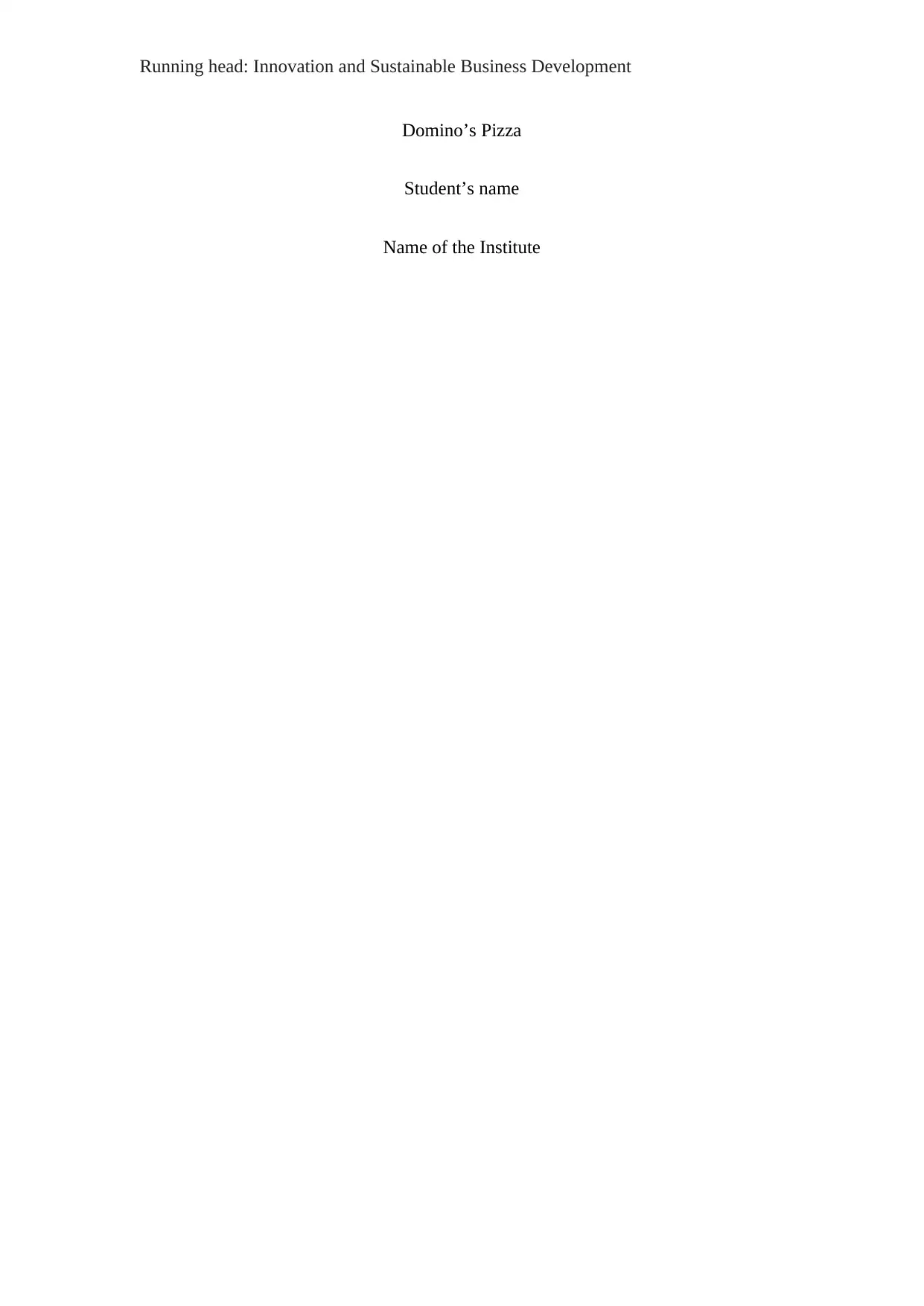
Running head: Innovation and Sustainable Business Development
Domino’s Pizza
Student’s name
Name of the Institute
Domino’s Pizza
Student’s name
Name of the Institute
Paraphrase This Document
Need a fresh take? Get an instant paraphrase of this document with our AI Paraphraser
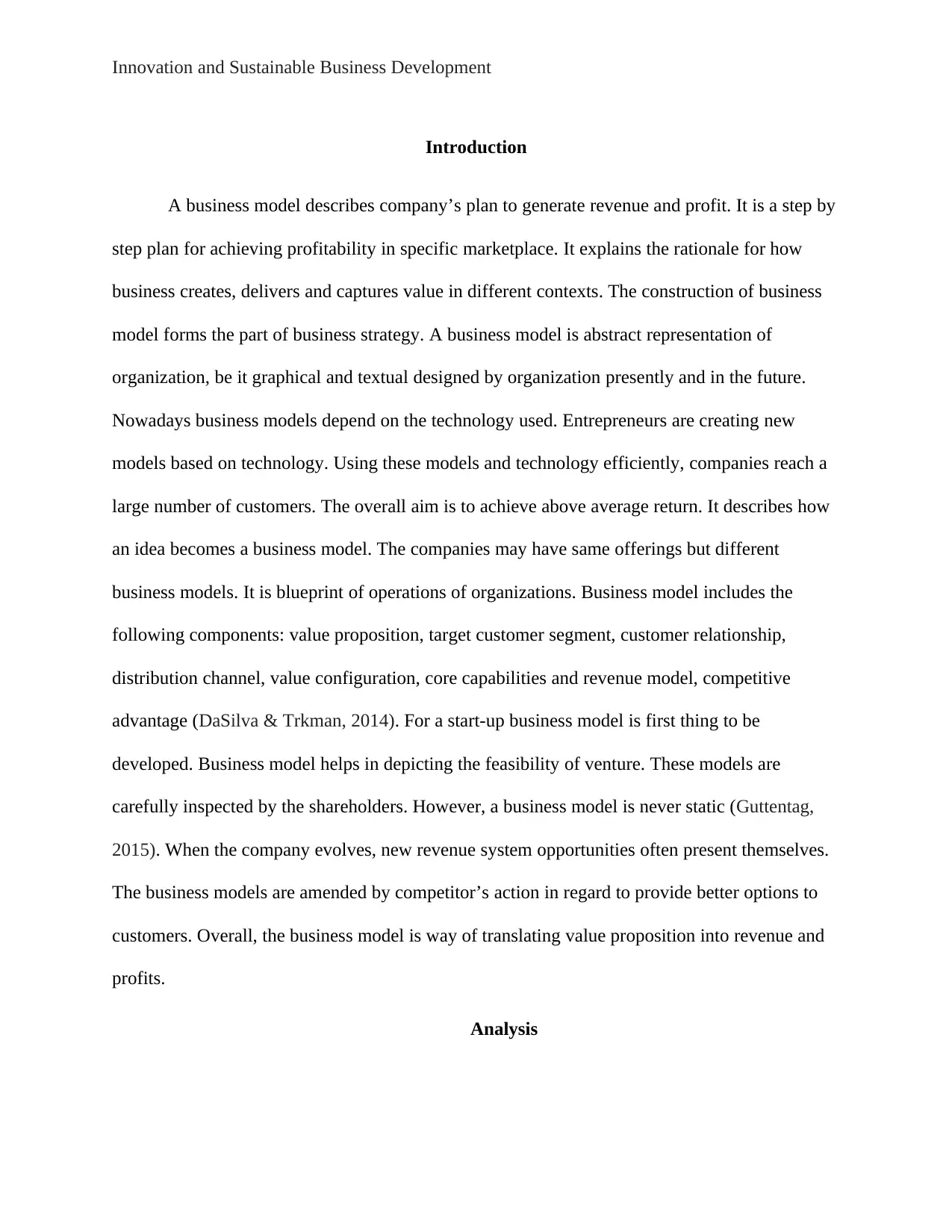
Innovation and Sustainable Business Development
Introduction
A business model describes company’s plan to generate revenue and profit. It is a step by
step plan for achieving profitability in specific marketplace. It explains the rationale for how
business creates, delivers and captures value in different contexts. The construction of business
model forms the part of business strategy. A business model is abstract representation of
organization, be it graphical and textual designed by organization presently and in the future.
Nowadays business models depend on the technology used. Entrepreneurs are creating new
models based on technology. Using these models and technology efficiently, companies reach a
large number of customers. The overall aim is to achieve above average return. It describes how
an idea becomes a business model. The companies may have same offerings but different
business models. It is blueprint of operations of organizations. Business model includes the
following components: value proposition, target customer segment, customer relationship,
distribution channel, value configuration, core capabilities and revenue model, competitive
advantage (DaSilva & Trkman, 2014). For a start-up business model is first thing to be
developed. Business model helps in depicting the feasibility of venture. These models are
carefully inspected by the shareholders. However, a business model is never static (Guttentag,
2015). When the company evolves, new revenue system opportunities often present themselves.
The business models are amended by competitor’s action in regard to provide better options to
customers. Overall, the business model is way of translating value proposition into revenue and
profits.
Analysis
Introduction
A business model describes company’s plan to generate revenue and profit. It is a step by
step plan for achieving profitability in specific marketplace. It explains the rationale for how
business creates, delivers and captures value in different contexts. The construction of business
model forms the part of business strategy. A business model is abstract representation of
organization, be it graphical and textual designed by organization presently and in the future.
Nowadays business models depend on the technology used. Entrepreneurs are creating new
models based on technology. Using these models and technology efficiently, companies reach a
large number of customers. The overall aim is to achieve above average return. It describes how
an idea becomes a business model. The companies may have same offerings but different
business models. It is blueprint of operations of organizations. Business model includes the
following components: value proposition, target customer segment, customer relationship,
distribution channel, value configuration, core capabilities and revenue model, competitive
advantage (DaSilva & Trkman, 2014). For a start-up business model is first thing to be
developed. Business model helps in depicting the feasibility of venture. These models are
carefully inspected by the shareholders. However, a business model is never static (Guttentag,
2015). When the company evolves, new revenue system opportunities often present themselves.
The business models are amended by competitor’s action in regard to provide better options to
customers. Overall, the business model is way of translating value proposition into revenue and
profits.
Analysis

Innovation and Sustainable Business Development
Disruption is problem or disturbance that disturbs process, activity or event. When
mainstream customers starts adopting the new offerings in bulk, the disruption has taken place
(Christensen & McDonald, 2016). It is powerful innovation driven growth. It basically defines
how emerging technology can redefine the ways of doing business. It emphasise on
understanding business engagement with customers and creating seamless experience. For
example virtual reality store by eBay, where shoppers can download the app on their mobile
phones, attach it with pair of shopticles and then start shopping in 3D. This is more than a
phenomenal way of engaging customers. Internet of things, Machine learning, Artificial
Intelligence are the digital disruptors and it would be harmful to underestimate their impact and
magnitude (Slama & Bhatnagar, 2015). Most of the companies try to follow the path of
digitization. It helps businesses to improve efficiency, offer better communication channels,
improve customer journey and enter into new segments. But it is necessary not to lure by these
technologies until the businesses get right Return on Investment on their business spend. The
customer should come first, so every decision should fulfil this agenda.
In this disruptive environment, established business models are less durable. These
models are rightly displaced and disrupted. For example online courses impact business schools.
There are long standing beliefs about customer preference, role of technology, cost drivers etc.
They are considered static until some player violates (Martins, L. L., Rindova, V. P., &
Greenbaum, 2015).
Dominos’ Pizza is one of the biggest pizza chains. It has repeatedly reported strong
growth in international retail. The company follows franchise model. It allows the company to
diversify, reduce the risk and earn above average returns. Domino’s Pizza Enterprises is the
master franchise of Dominos in Australia.
Disruption is problem or disturbance that disturbs process, activity or event. When
mainstream customers starts adopting the new offerings in bulk, the disruption has taken place
(Christensen & McDonald, 2016). It is powerful innovation driven growth. It basically defines
how emerging technology can redefine the ways of doing business. It emphasise on
understanding business engagement with customers and creating seamless experience. For
example virtual reality store by eBay, where shoppers can download the app on their mobile
phones, attach it with pair of shopticles and then start shopping in 3D. This is more than a
phenomenal way of engaging customers. Internet of things, Machine learning, Artificial
Intelligence are the digital disruptors and it would be harmful to underestimate their impact and
magnitude (Slama & Bhatnagar, 2015). Most of the companies try to follow the path of
digitization. It helps businesses to improve efficiency, offer better communication channels,
improve customer journey and enter into new segments. But it is necessary not to lure by these
technologies until the businesses get right Return on Investment on their business spend. The
customer should come first, so every decision should fulfil this agenda.
In this disruptive environment, established business models are less durable. These
models are rightly displaced and disrupted. For example online courses impact business schools.
There are long standing beliefs about customer preference, role of technology, cost drivers etc.
They are considered static until some player violates (Martins, L. L., Rindova, V. P., &
Greenbaum, 2015).
Dominos’ Pizza is one of the biggest pizza chains. It has repeatedly reported strong
growth in international retail. The company follows franchise model. It allows the company to
diversify, reduce the risk and earn above average returns. Domino’s Pizza Enterprises is the
master franchise of Dominos in Australia.
⊘ This is a preview!⊘
Do you want full access?
Subscribe today to unlock all pages.

Trusted by 1+ million students worldwide
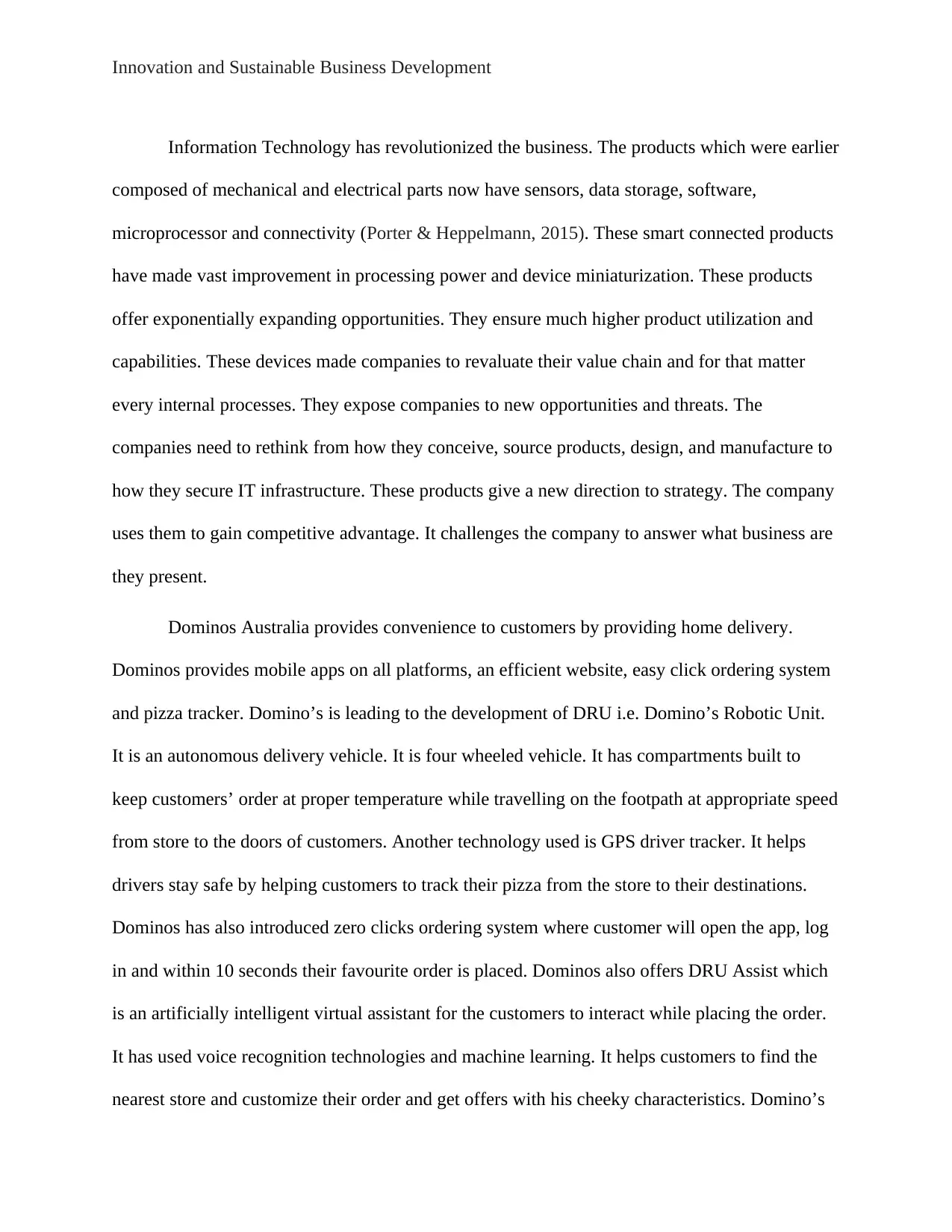
Innovation and Sustainable Business Development
Information Technology has revolutionized the business. The products which were earlier
composed of mechanical and electrical parts now have sensors, data storage, software,
microprocessor and connectivity (Porter & Heppelmann, 2015). These smart connected products
have made vast improvement in processing power and device miniaturization. These products
offer exponentially expanding opportunities. They ensure much higher product utilization and
capabilities. These devices made companies to revaluate their value chain and for that matter
every internal processes. They expose companies to new opportunities and threats. The
companies need to rethink from how they conceive, source products, design, and manufacture to
how they secure IT infrastructure. These products give a new direction to strategy. The company
uses them to gain competitive advantage. It challenges the company to answer what business are
they present.
Dominos Australia provides convenience to customers by providing home delivery.
Dominos provides mobile apps on all platforms, an efficient website, easy click ordering system
and pizza tracker. Domino’s is leading to the development of DRU i.e. Domino’s Robotic Unit.
It is an autonomous delivery vehicle. It is four wheeled vehicle. It has compartments built to
keep customers’ order at proper temperature while travelling on the footpath at appropriate speed
from store to the doors of customers. Another technology used is GPS driver tracker. It helps
drivers stay safe by helping customers to track their pizza from the store to their destinations.
Dominos has also introduced zero clicks ordering system where customer will open the app, log
in and within 10 seconds their favourite order is placed. Dominos also offers DRU Assist which
is an artificially intelligent virtual assistant for the customers to interact while placing the order.
It has used voice recognition technologies and machine learning. It helps customers to find the
nearest store and customize their order and get offers with his cheeky characteristics. Domino’s
Information Technology has revolutionized the business. The products which were earlier
composed of mechanical and electrical parts now have sensors, data storage, software,
microprocessor and connectivity (Porter & Heppelmann, 2015). These smart connected products
have made vast improvement in processing power and device miniaturization. These products
offer exponentially expanding opportunities. They ensure much higher product utilization and
capabilities. These devices made companies to revaluate their value chain and for that matter
every internal processes. They expose companies to new opportunities and threats. The
companies need to rethink from how they conceive, source products, design, and manufacture to
how they secure IT infrastructure. These products give a new direction to strategy. The company
uses them to gain competitive advantage. It challenges the company to answer what business are
they present.
Dominos Australia provides convenience to customers by providing home delivery.
Dominos provides mobile apps on all platforms, an efficient website, easy click ordering system
and pizza tracker. Domino’s is leading to the development of DRU i.e. Domino’s Robotic Unit.
It is an autonomous delivery vehicle. It is four wheeled vehicle. It has compartments built to
keep customers’ order at proper temperature while travelling on the footpath at appropriate speed
from store to the doors of customers. Another technology used is GPS driver tracker. It helps
drivers stay safe by helping customers to track their pizza from the store to their destinations.
Dominos has also introduced zero clicks ordering system where customer will open the app, log
in and within 10 seconds their favourite order is placed. Dominos also offers DRU Assist which
is an artificially intelligent virtual assistant for the customers to interact while placing the order.
It has used voice recognition technologies and machine learning. It helps customers to find the
nearest store and customize their order and get offers with his cheeky characteristics. Domino’s
Paraphrase This Document
Need a fresh take? Get an instant paraphrase of this document with our AI Paraphraser
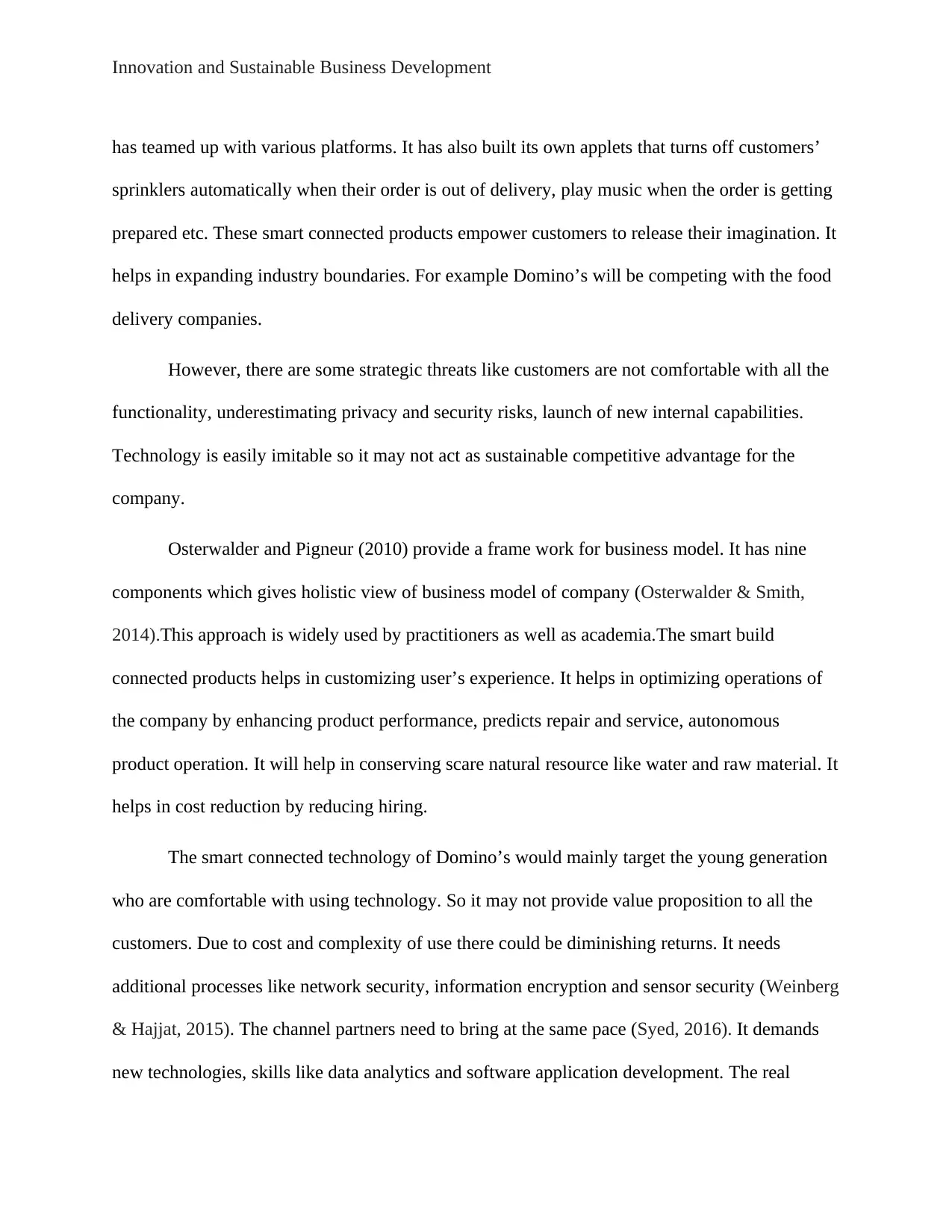
Innovation and Sustainable Business Development
has teamed up with various platforms. It has also built its own applets that turns off customers’
sprinklers automatically when their order is out of delivery, play music when the order is getting
prepared etc. These smart connected products empower customers to release their imagination. It
helps in expanding industry boundaries. For example Domino’s will be competing with the food
delivery companies.
However, there are some strategic threats like customers are not comfortable with all the
functionality, underestimating privacy and security risks, launch of new internal capabilities.
Technology is easily imitable so it may not act as sustainable competitive advantage for the
company.
Osterwalder and Pigneur (2010) provide a frame work for business model. It has nine
components which gives holistic view of business model of company (Osterwalder & Smith,
2014).This approach is widely used by practitioners as well as academia.The smart build
connected products helps in customizing user’s experience. It helps in optimizing operations of
the company by enhancing product performance, predicts repair and service, autonomous
product operation. It will help in conserving scare natural resource like water and raw material. It
helps in cost reduction by reducing hiring.
The smart connected technology of Domino’s would mainly target the young generation
who are comfortable with using technology. So it may not provide value proposition to all the
customers. Due to cost and complexity of use there could be diminishing returns. It needs
additional processes like network security, information encryption and sensor security (Weinberg
& Hajjat, 2015). The channel partners need to bring at the same pace (Syed, 2016). It demands
new technologies, skills like data analytics and software application development. The real
has teamed up with various platforms. It has also built its own applets that turns off customers’
sprinklers automatically when their order is out of delivery, play music when the order is getting
prepared etc. These smart connected products empower customers to release their imagination. It
helps in expanding industry boundaries. For example Domino’s will be competing with the food
delivery companies.
However, there are some strategic threats like customers are not comfortable with all the
functionality, underestimating privacy and security risks, launch of new internal capabilities.
Technology is easily imitable so it may not act as sustainable competitive advantage for the
company.
Osterwalder and Pigneur (2010) provide a frame work for business model. It has nine
components which gives holistic view of business model of company (Osterwalder & Smith,
2014).This approach is widely used by practitioners as well as academia.The smart build
connected products helps in customizing user’s experience. It helps in optimizing operations of
the company by enhancing product performance, predicts repair and service, autonomous
product operation. It will help in conserving scare natural resource like water and raw material. It
helps in cost reduction by reducing hiring.
The smart connected technology of Domino’s would mainly target the young generation
who are comfortable with using technology. So it may not provide value proposition to all the
customers. Due to cost and complexity of use there could be diminishing returns. It needs
additional processes like network security, information encryption and sensor security (Weinberg
& Hajjat, 2015). The channel partners need to bring at the same pace (Syed, 2016). It demands
new technologies, skills like data analytics and software application development. The real
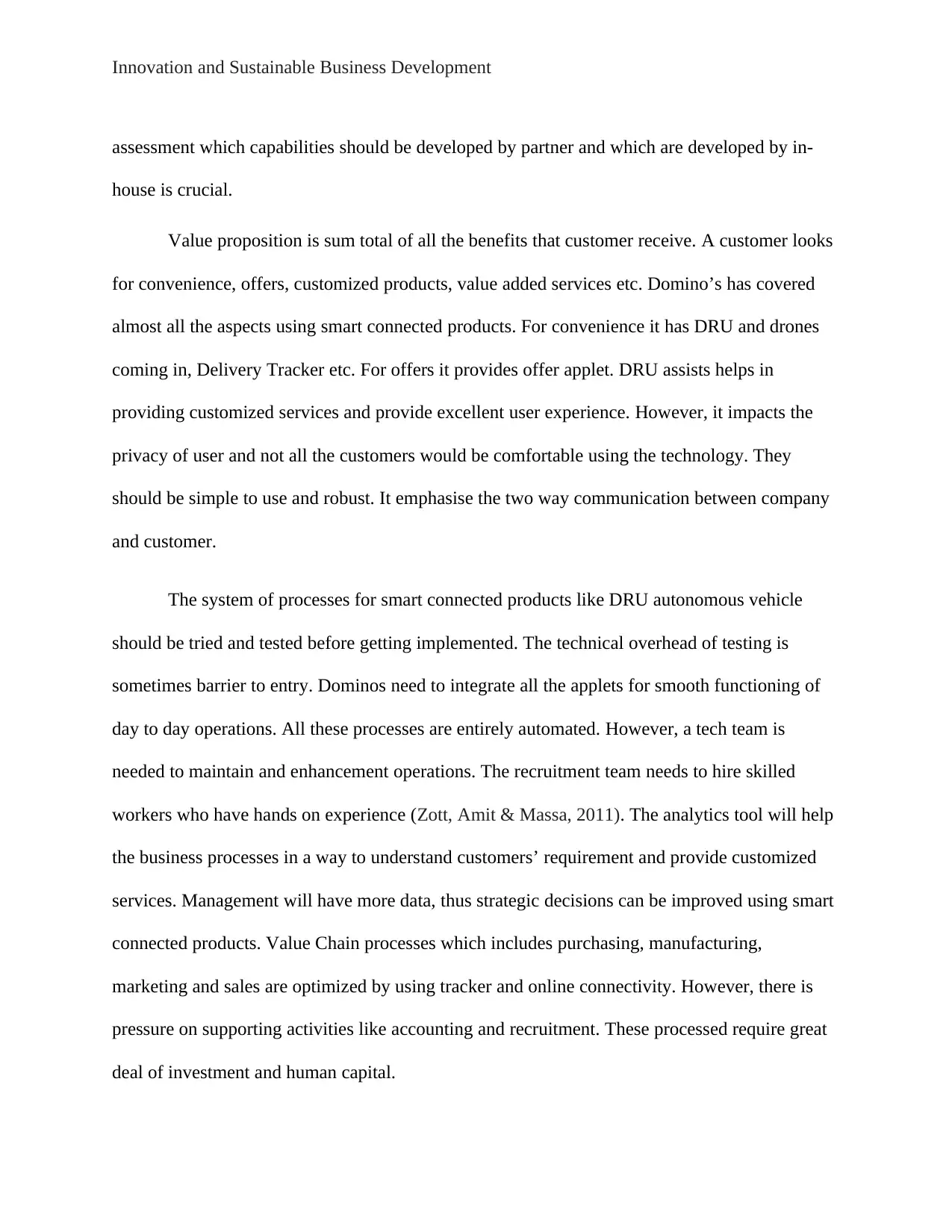
Innovation and Sustainable Business Development
assessment which capabilities should be developed by partner and which are developed by in-
house is crucial.
Value proposition is sum total of all the benefits that customer receive. A customer looks
for convenience, offers, customized products, value added services etc. Domino’s has covered
almost all the aspects using smart connected products. For convenience it has DRU and drones
coming in, Delivery Tracker etc. For offers it provides offer applet. DRU assists helps in
providing customized services and provide excellent user experience. However, it impacts the
privacy of user and not all the customers would be comfortable using the technology. They
should be simple to use and robust. It emphasise the two way communication between company
and customer.
The system of processes for smart connected products like DRU autonomous vehicle
should be tried and tested before getting implemented. The technical overhead of testing is
sometimes barrier to entry. Dominos need to integrate all the applets for smooth functioning of
day to day operations. All these processes are entirely automated. However, a tech team is
needed to maintain and enhancement operations. The recruitment team needs to hire skilled
workers who have hands on experience (Zott, Amit & Massa, 2011). The analytics tool will help
the business processes in a way to understand customers’ requirement and provide customized
services. Management will have more data, thus strategic decisions can be improved using smart
connected products. Value Chain processes which includes purchasing, manufacturing,
marketing and sales are optimized by using tracker and online connectivity. However, there is
pressure on supporting activities like accounting and recruitment. These processed require great
deal of investment and human capital.
assessment which capabilities should be developed by partner and which are developed by in-
house is crucial.
Value proposition is sum total of all the benefits that customer receive. A customer looks
for convenience, offers, customized products, value added services etc. Domino’s has covered
almost all the aspects using smart connected products. For convenience it has DRU and drones
coming in, Delivery Tracker etc. For offers it provides offer applet. DRU assists helps in
providing customized services and provide excellent user experience. However, it impacts the
privacy of user and not all the customers would be comfortable using the technology. They
should be simple to use and robust. It emphasise the two way communication between company
and customer.
The system of processes for smart connected products like DRU autonomous vehicle
should be tried and tested before getting implemented. The technical overhead of testing is
sometimes barrier to entry. Dominos need to integrate all the applets for smooth functioning of
day to day operations. All these processes are entirely automated. However, a tech team is
needed to maintain and enhancement operations. The recruitment team needs to hire skilled
workers who have hands on experience (Zott, Amit & Massa, 2011). The analytics tool will help
the business processes in a way to understand customers’ requirement and provide customized
services. Management will have more data, thus strategic decisions can be improved using smart
connected products. Value Chain processes which includes purchasing, manufacturing,
marketing and sales are optimized by using tracker and online connectivity. However, there is
pressure on supporting activities like accounting and recruitment. These processed require great
deal of investment and human capital.
⊘ This is a preview!⊘
Do you want full access?
Subscribe today to unlock all pages.

Trusted by 1+ million students worldwide
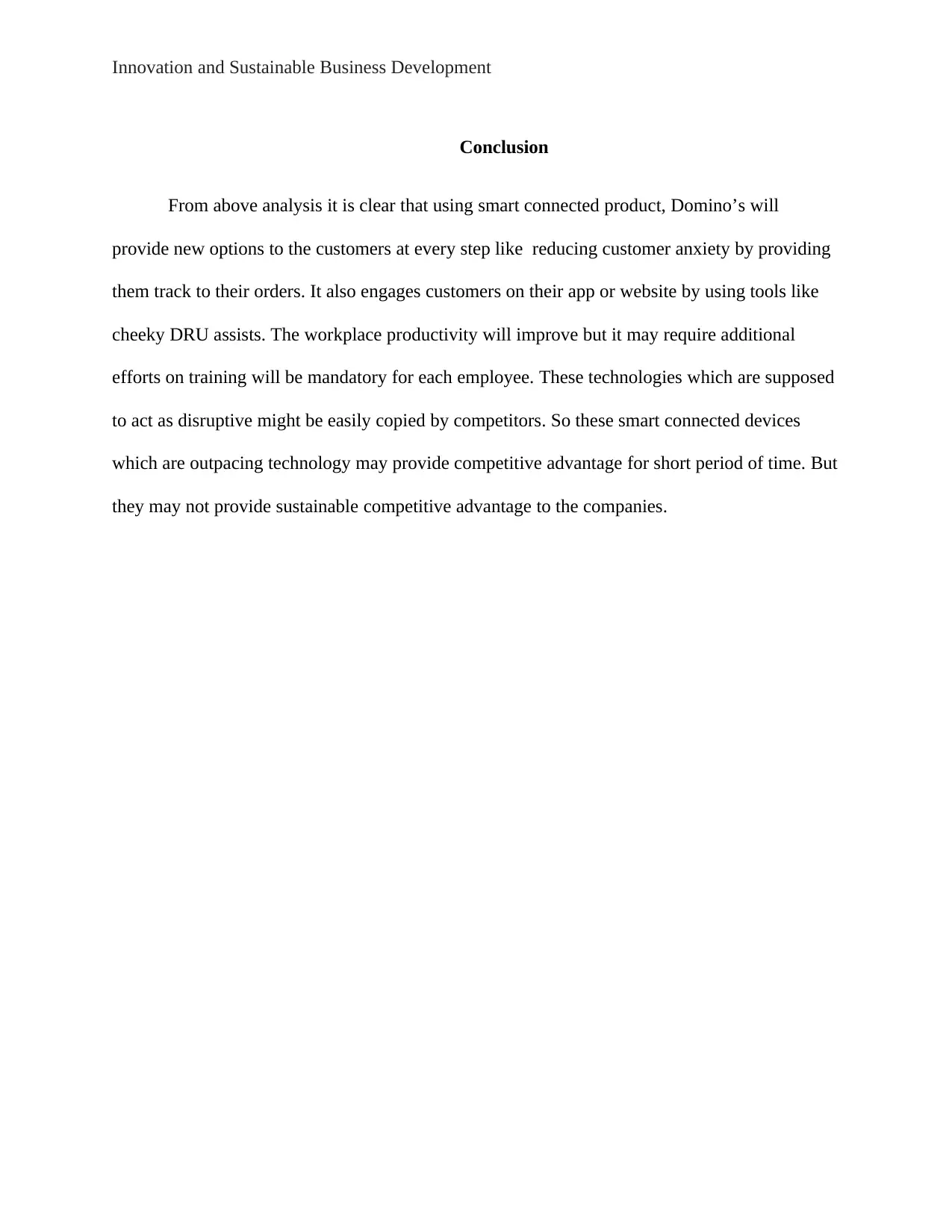
Innovation and Sustainable Business Development
Conclusion
From above analysis it is clear that using smart connected product, Domino’s will
provide new options to the customers at every step like reducing customer anxiety by providing
them track to their orders. It also engages customers on their app or website by using tools like
cheeky DRU assists. The workplace productivity will improve but it may require additional
efforts on training will be mandatory for each employee. These technologies which are supposed
to act as disruptive might be easily copied by competitors. So these smart connected devices
which are outpacing technology may provide competitive advantage for short period of time. But
they may not provide sustainable competitive advantage to the companies.
Conclusion
From above analysis it is clear that using smart connected product, Domino’s will
provide new options to the customers at every step like reducing customer anxiety by providing
them track to their orders. It also engages customers on their app or website by using tools like
cheeky DRU assists. The workplace productivity will improve but it may require additional
efforts on training will be mandatory for each employee. These technologies which are supposed
to act as disruptive might be easily copied by competitors. So these smart connected devices
which are outpacing technology may provide competitive advantage for short period of time. But
they may not provide sustainable competitive advantage to the companies.
Paraphrase This Document
Need a fresh take? Get an instant paraphrase of this document with our AI Paraphraser
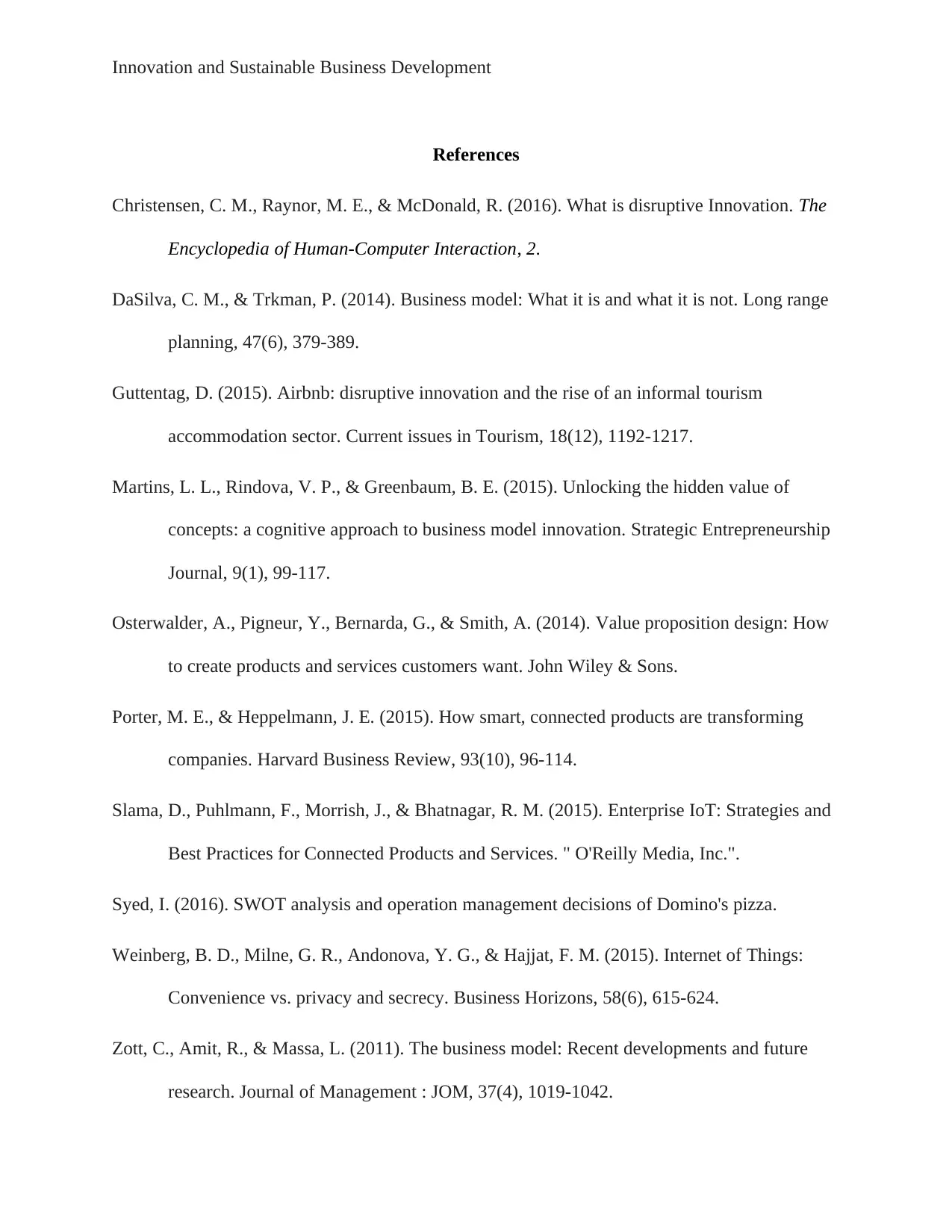
Innovation and Sustainable Business Development
References
Christensen, C. M., Raynor, M. E., & McDonald, R. (2016). What is disruptive Innovation. The
Encyclopedia of Human-Computer Interaction, 2.
DaSilva, C. M., & Trkman, P. (2014). Business model: What it is and what it is not. Long range
planning, 47(6), 379-389.
Guttentag, D. (2015). Airbnb: disruptive innovation and the rise of an informal tourism
accommodation sector. Current issues in Tourism, 18(12), 1192-1217.
Martins, L. L., Rindova, V. P., & Greenbaum, B. E. (2015). Unlocking the hidden value of
concepts: a cognitive approach to business model innovation. Strategic Entrepreneurship
Journal, 9(1), 99-117.
Osterwalder, A., Pigneur, Y., Bernarda, G., & Smith, A. (2014). Value proposition design: How
to create products and services customers want. John Wiley & Sons.
Porter, M. E., & Heppelmann, J. E. (2015). How smart, connected products are transforming
companies. Harvard Business Review, 93(10), 96-114.
Slama, D., Puhlmann, F., Morrish, J., & Bhatnagar, R. M. (2015). Enterprise IoT: Strategies and
Best Practices for Connected Products and Services. " O'Reilly Media, Inc.".
Syed, I. (2016). SWOT analysis and operation management decisions of Domino's pizza.
Weinberg, B. D., Milne, G. R., Andonova, Y. G., & Hajjat, F. M. (2015). Internet of Things:
Convenience vs. privacy and secrecy. Business Horizons, 58(6), 615-624.
Zott, C., Amit, R., & Massa, L. (2011). The business model: Recent developments and future
research. Journal of Management : JOM, 37(4), 1019-1042.
References
Christensen, C. M., Raynor, M. E., & McDonald, R. (2016). What is disruptive Innovation. The
Encyclopedia of Human-Computer Interaction, 2.
DaSilva, C. M., & Trkman, P. (2014). Business model: What it is and what it is not. Long range
planning, 47(6), 379-389.
Guttentag, D. (2015). Airbnb: disruptive innovation and the rise of an informal tourism
accommodation sector. Current issues in Tourism, 18(12), 1192-1217.
Martins, L. L., Rindova, V. P., & Greenbaum, B. E. (2015). Unlocking the hidden value of
concepts: a cognitive approach to business model innovation. Strategic Entrepreneurship
Journal, 9(1), 99-117.
Osterwalder, A., Pigneur, Y., Bernarda, G., & Smith, A. (2014). Value proposition design: How
to create products and services customers want. John Wiley & Sons.
Porter, M. E., & Heppelmann, J. E. (2015). How smart, connected products are transforming
companies. Harvard Business Review, 93(10), 96-114.
Slama, D., Puhlmann, F., Morrish, J., & Bhatnagar, R. M. (2015). Enterprise IoT: Strategies and
Best Practices for Connected Products and Services. " O'Reilly Media, Inc.".
Syed, I. (2016). SWOT analysis and operation management decisions of Domino's pizza.
Weinberg, B. D., Milne, G. R., Andonova, Y. G., & Hajjat, F. M. (2015). Internet of Things:
Convenience vs. privacy and secrecy. Business Horizons, 58(6), 615-624.
Zott, C., Amit, R., & Massa, L. (2011). The business model: Recent developments and future
research. Journal of Management : JOM, 37(4), 1019-1042.
1 out of 8
Related Documents
Your All-in-One AI-Powered Toolkit for Academic Success.
+13062052269
info@desklib.com
Available 24*7 on WhatsApp / Email
![[object Object]](/_next/static/media/star-bottom.7253800d.svg)
Unlock your academic potential
Copyright © 2020–2025 A2Z Services. All Rights Reserved. Developed and managed by ZUCOL.



